Remembering Mir Javed Rahman: A Tribute to a Journalism Icon
- 30 Mar - 05 Apr, 2024
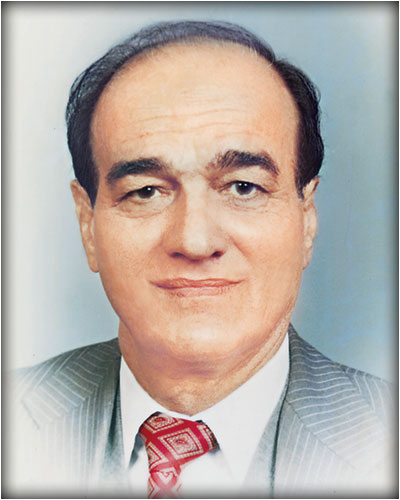
His path was full of difficulties and unknown challenges, the political and ethnic circles of the time had an agenda that made his vision almost impossible to materialise but the man never gave up. Constantly striving to bring about a change in the thoughts and action of the Muslims of the subcontinent and to fuel the newly-initiated movement for the recognition of their rights, Mir Khalil-ur-Rahman in a bold move launched the Jang in 1941 from Delhi.
The pre-independence era was a tough time for journalism and the press was far from free. All this however was to change in the years to come and Mir saheb set the wheels in motion. Though only 19 years of age, his ambitions were anything but ordinary. The initiation of a new daily newspaper with an agenda different from any other newspaper of the time was a huge step forward in this regard. Unlike others, not succumbing to the political pressures, Mir saheb clearly declared Jang as the voice of the All India Muslim League with a mission to support the movement for independence.
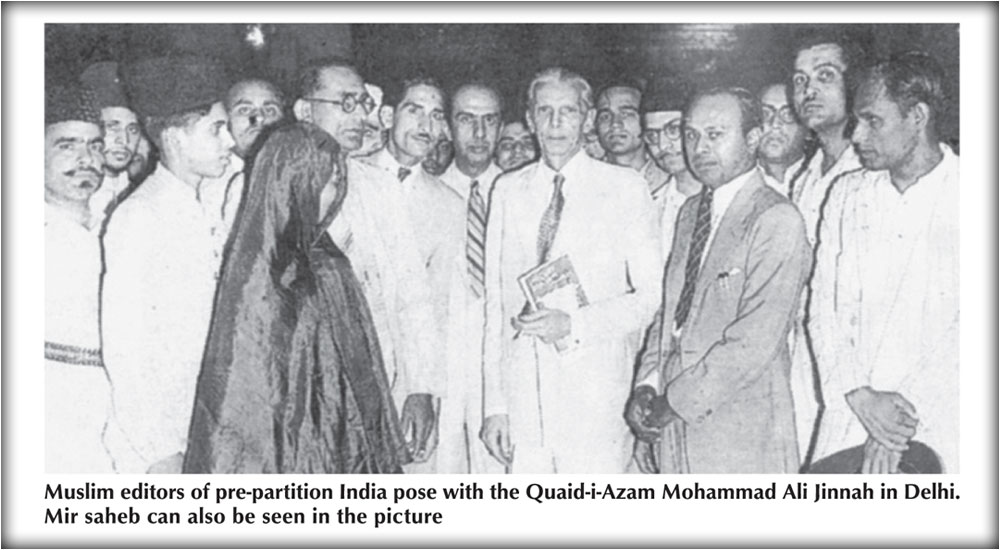
From an early stage of his life, Mir-saheb was a far-sighted man and calculated every move in order to strengthen the influence and power of his newspaper and consequently the Pakistan Movement. It was this support for the Movement that made him not only emerge as an integral political figure of the time but also a powerful journalist through his influence over the print media.
Mir saheb’s contributions can never be forgotten and after the creation of Pakistan, the Quaid-i-Azam himself acknowledged his efforts and contribution towards establishing a free press and supporting the Pakistan movement.
The formal launch of Jang in Karachi, Pakistan was a start of a new journey in Mir saheb’s life – a journey to take Jang to new heights and to establish the highest standards for journalistic practices in Pakistan that were at par with international principles. “Mir Khalil-ur-Rahman was the shining star of journalism and a prominent historic personality,” comments Abdul Majeed Memon, President of Press Club, Kunri.
With this goal in mind Mir saheb closely observed the workings of foreign media organisations and learnt the tricks of the trade. He then modified those and put forth new ones based on his extensive experience and knowledge to bring about a change for the better. Mir saheb encouraged his reporters to not only report the obvious but also to look deeper and peruse a fresh angle that had gone unnoticed before. Keeping up with changing times he also introduced new topics and areas of information in his newspaper to encourage a wider audience to read and take interest in the newspaper.
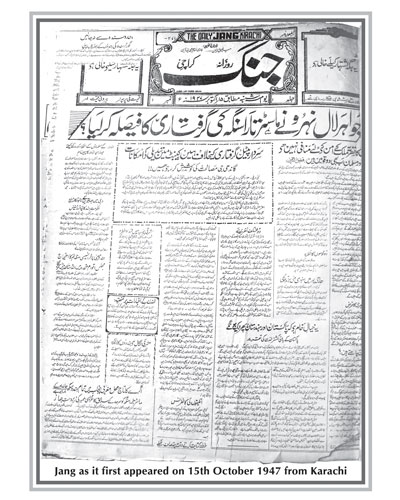
Mir saheb’s vision was to establish a state of the art news organisation and for this he spent day and night trying to bring about improvements in the techniques of news reporting and also introduced new technologies with regards to newspaper publication. It seemed that innovation and revolution had become Mir saheb’s nature and perhaps the best effort in this regard was his initiative of introducing the computerised composing of newspapers. He also introduced computerised Nastaleeq in his newspaper. This definitely set Jang apart from all other newspapers that later, following the lead, adopted this technology too.
“Mir Khalil-ur-Rahman during his lifetime did not claim to have started a revolution; instead he kept working hard silently. Today he is not amongst us but due to his sheer hard work and dedication, a silent revolution has been witnessed in the newspaper industry, so much so that not only newspaper readers but also the other institutions around the world are enjoying the fruits of this revolution,” says Khalil Malik.
Mir saheb had an untiring will and determination. He realised that knowledge was the key to success and thus began his efforts to encourage the masses to read and benefit from his newspaper. How much he succeeded can be seen from the fact that despite a literacy rate of only 3 per cent Mir saheb managed to raise his readership to a great extent.
As time passed Jang grew in popularity and soon Mir saheb launched The News, an English daily to counter the competition and to cater to an even wider audience, in the early ’90s. “The products and proofs of Mir Khalil-ur-Rahman’s personal hard work, interest, intelligence and far-sightedness – the Daily Jang Karachi, Lahore, Rawalpindi, Quetta, Multan and London and The News Karachi, Lahore, Rawalpindi and London are today in the forefront by the grace of God. Due to the sheer hard work and efforts of generations of employees, today the Jang Group is considered among the biggest newspaper institutions of South Asia.
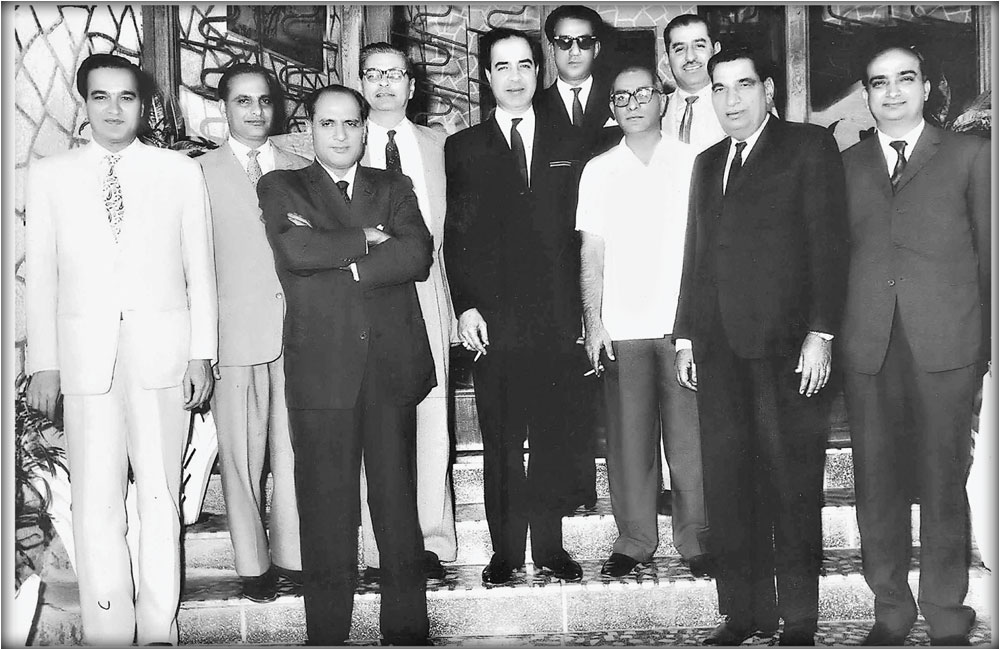
At Mir Khalil-ur-Rahman’s former S.M.C.H.S. residence, Karachi (R - L) J. C. Anand, Syed Mukhtar Ahmed, Nisar Murad (Waheed Murad’s father in dark glasses), Mehmood Haroon, Dr. Majeed Akhtar (3rd left with arms folded, at present he is 97 years old, hale and hearty living in U.S.), Sultan Ahmed, Yousuf Mitha (owner of Rex Cinema) and Mir Khalil-ur-Rahman with other dignitaries
From Karachi to the Line of Control, each morning begins with Jang. Mir Khalil-ur-Rahman never wished for his accounts of praise to be published in his honour. Neither did he wish for his pictures or news about him to be published in newspapers. He never let his personal views and ego interfere with his professional life. He only gave importance to the nation and his readers. He wrote what the readers wanted and said what the nation said,” says Mahmood Sham, praising the works of Mir saheb.
Mir saheb’s personality was a blend of worldly success and humble temperament. In his personal life, Mir saheb was a down to earth man and kept to his family and close friends. Contrary to the stereotypical image of autocratic editors he was a man of simple habits and was not a fan of lavishly spending on himself but of simple living and was often seen giving the same advice to friends and colleagues. Easy to approach and talk to, Mir saheb always took good care of his employees and their needs. Being the man of principles that he was, he never used his authority to pressurise others or a harsh tone while talking to his subordinates. He said, “If you know how to put your point forward, then without saying the obvious and being harsh you can say everything.”
The creator of his own institution, he never seemed to tire out or give up in the face of hardships. He worked hard all day long each day and made sure that his organisation functioned smoothly. He would sit in the office all day long till the newspaper went to the press and then would make sure that it was picked by the delivery boys and distributed. Such was his dedication and untiring effort.
Mir saheb has left an indelible mark on the journalistic history of Pakistan. The empire that he has left behind is an asset and a source of inspiration for the nation and today, even 26 years after his death, Mir saheb still lives through his works and contributions that form the very core of Pakistani journalism.
MKR has rendered innumerable services to journalism. In an exclusive interview with The News, Jamiluddin A’ali talks about MKR – a friend and a colleague.
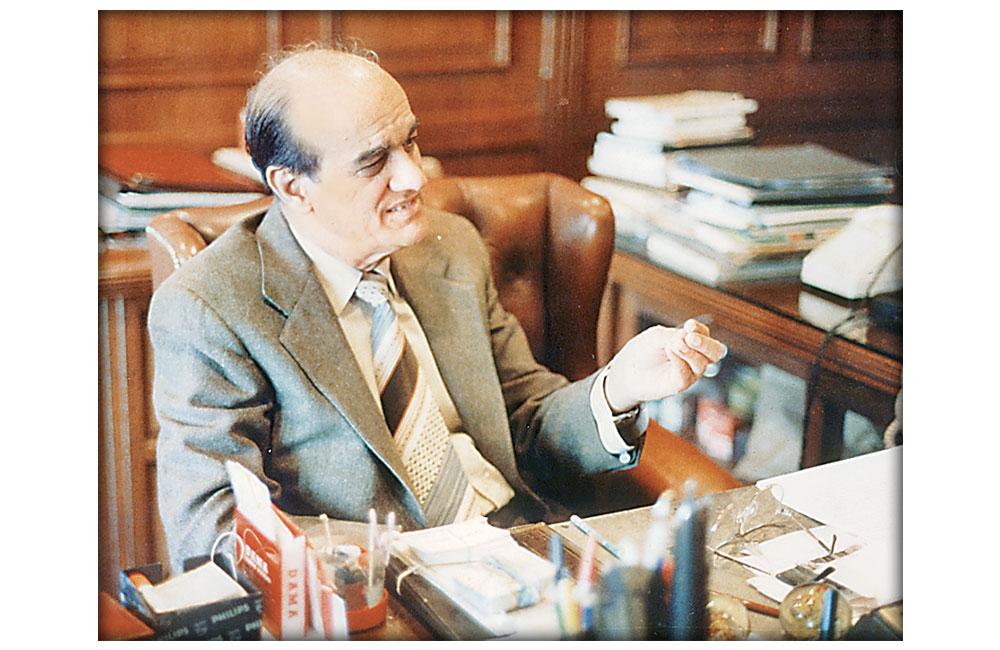
“No matter whether it is his death anniversary or birthday, I always remember Mir Khalil-ur Rahman for being a nice human being and a close friend. Moreover, it is his great deeds and services rendered in the field of journalism, and in my case true friendship which make him a memorable personality,” said renowned poet and scholar, Jamiluddin A’ali while commenting on the role of MKR in the field of journalism.
The great works of MKR are an asset to journalists all over the country and have been recorded as a golden chapter in the history of Pakistani journalism. Recalling his days with MKR, A’ali observed, “Mir saheb not only made Jang into a great Urdu newspaper and Akhbar-e-Jahan into a famous and widely circulated Urdu weekly, but also enriched English journalism in Pakistan by introducing MAG, Daily News, The News and by setting up other journalistic organisations. Besides this, through his newspapers and magazines, both in Urdu and English, he introduced and promoted investigative, creative and ethical journalism. In other words, MKR set an exemplary trend in the field of Urdu and English journalism.”
While soliloquising over the days of his friendship with MKR, A’ali said, “he was a very articulate friend and never rejected my suggestions.”
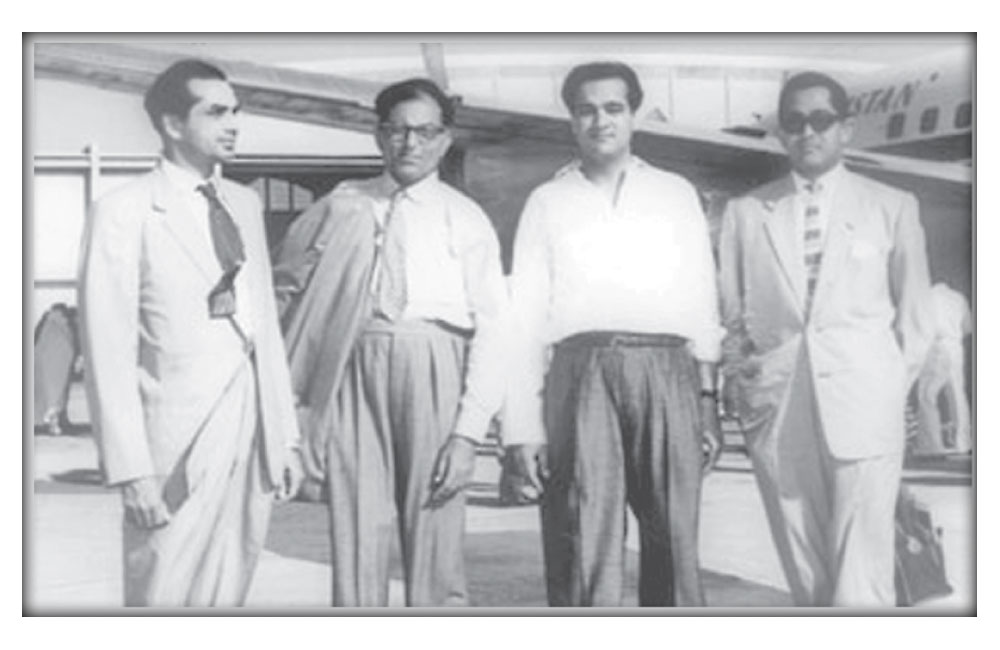
“It was on my desire that he started a literary page in daily Jang, which to date is being printed and promoting new literary works. As a matter of fact, at one point, he also asked me to write a column about culture and literature for his reputed paper, which gained me popularity amongst the readers. I wrote this column for quite a long time.”
Moreover, he had allotted certain pages in his papers and magazines as his personal contribution to promoting good literature in the Pakistani society.
Mir saheb was a keen observer and knew well the inclination and the interests of his writers. It was because of this sharp observation about different people’s writing skills that he was always able to find the right people with the required temperament to write on a particular subject.
A’ali further added that he is very glad when he looks at the new heights of success attained by the Jang group. Together his sons have played an important role in the promotion of true journalistic values in the society. The foundation of Geo TV was an action that not only revolutionised the entire media industry, but also turned his own organisation into a complete media organisation with a print media wing, and an electronic media wing. The weekly Akhbar-e-Jahan also proved an immense success by covering a variety of issues in this weekly magazine, giving especial prominence to issues which help promote health, cultural and literary values.
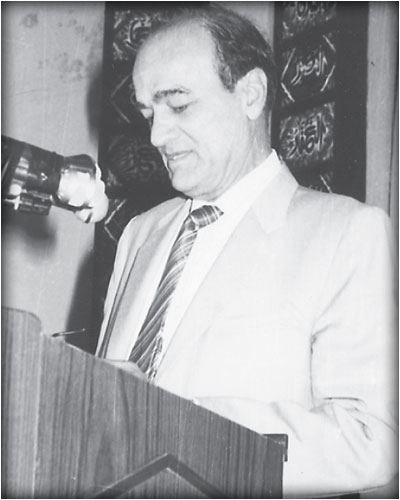
In the chequered history of the growth of journalism in Pakistan the figure of Mir Khalil-ur-Rahman stands out tall in its own right and is amply supported by his success in the field of journalism in the subcontinent. This was because Mir Khalil-ur-Rahman, through the sheer dint of his hard labour and persistence achieved success where others failed. Not only that, he also set an example for others to follow with respect to adhering to a goal single-mindedly and working towards its achievement with undivided attention and devotion.
It was in the early ’40s that Mir Khalil-ur-Rahman began his arduous journey in the field of journalism from New Delhi, the capital of British India before partition. He began publishing the Jang from New Delhi in 1942. Jang was a newspaper that was devoted to the cause of the Muslims freedom struggle, because Mir saheb himself had complete faith in the leadership of the Quaid-i-Azam Mohammad Ali Jinnah. Once Pakistan became a reality on the world map, he migrated here, like many other Muslims in New Delhi, and took up residence in Karachi, the then federal capital of Pakistan. At approximately the same time, I began my journey in practical journalism in 1949 along with my brother Qutubuddin Aziz, with United Press of Pakistan Ltd, an independent private sector news agency established by our late father, Syed Abdul Hafiz, one of the pioneers of Muslim journalism in the subcontinent.
I had a great friend in Khan Bahadur H M Habibullah, a coal-mining tycoon from Campbellpur who built his fortunes while mining coal in Balochistan. K B H M Habibullah was a close friend of Mir Khalil-ur-Rahman’s too, and I often met Mir saheb at Habibullah’s lunch table. Our meetings during those early days after the establishment of Pakistan were to lead to a firm friendship and understanding between Mir Khalil-ur-Rahman and myself in later years.
Since Mir Khalil-ur-Rahman, even though he owned the daily Jang, remained active in the reporting field too, we often met at press conferences, or at lunches or dinners given by well known personalities for pressmen. It was a time when the dedication to the Pakistan ideology was a prominent feature among newspaper editors and their main effort was to make a success of Pakistan so that the predictions of the Hindu Mahasabha leadership that Pakistan would not last for even a year could be proved wrong.
The success of Pakistan in its early years, its emergence as a Muslim power in the world and its advocacy of Islamic solidarity were goals that found ready support amongst the editors of Pakistan’s newspaper community. Mir Khalil-ur-Rahman, true to the ideology of Pakistan, always spoke out and wrote strongly to defend the country’s ideological basis and its destiny as a Muslim nation. It was his faith in Pakistan that in a way inspired me too, and I sought out to establish the closest ties with the Saudi Arabian diplomats in Pakistan and through them with the Saudi Arabian leadership. I was soon organising supplements in Pakistani newspapers on Saudi Arabia and Mir Khalil-ur-Rahman gave me his full support in my efforts for which I shall forever remain grateful to him.
When he introduced colour printing in newspapers in Pakistan in the late ’50s and early ’60s, many amongst the press society thought it was too early to introduce colour printing in newspapers. Within a year however, they were all following Jang’s example, in fact, the Pakistani press led the rest of the Muslim world in being the first to introduce colour printing in their newspapers.
Mir Khalil-ur-Rahman was also blessed with human qualities that endeared him to his friends. I worked with him in the Council of Pakistan Newspaper Editors (CPNE) for a very long time and realised that whenever there was a crisis, he went along with the policies of the CPNE and supported press freedom and rejected any action that the government might have taken against newspapers which had exercised their right of editorial freedom.
In all government press relations Mir saheb always advised a course of action that would maintain the objectives of the Editors community without rousing agitation and harming the relations between the government and the press.
I can still remember my meeting with him in the hospital room during his last illness in 1991 when he told me, before his wife and his son Mir Shakil-ur-Rahman, that he always wanted the goodwill of all his colleagues in the field of journalism and wished them well. He had nothing but encouragement for fellow journalists and once persuaded a fellow journalist, Umar Farooqui to start his own evening daily, Aghaz, after the latter had been ousted from the Daily Anjam.
Mir saheb didn’t just support individual journalists, but fought for the rights of rival newspaper organisations too. During the early days, Karachi had had two rival papers, the Roznama Jang and Anjam, as the leading papers of the city.
It did not receive many government grants however, and whenever we lambasted the federal and provincial governments for pressuring Nawa-i-Waqt, in the CPNE, Mir Khalil-ur-Rahman and the Jang Group always supported the CPNE’s stance, and demanded the removal of all restrictions on newspapers and release of advertisements to the newspapers by government organisations without discrimination. Mir Khalil-ur-Rahman often represented Pakistan at many international meetings of newspaper editors at which he would always speak out about the problems being faced by his country and demand for their earliest resolution.
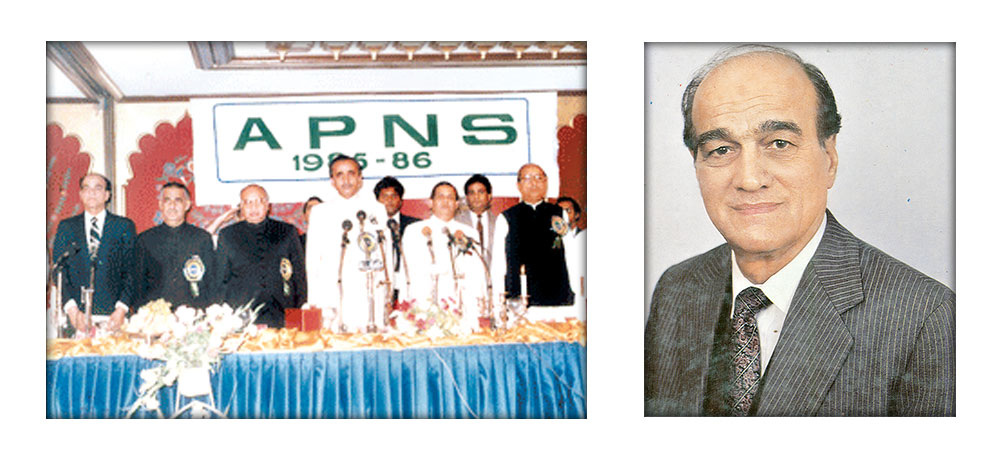
MKR: A sincere friend of his colleagues At a personal level, Mir saheb was a sincere friend who was always willing to reach out and stand by me whenever I suffered undue government pressure for having rejected some of their demands.
Mir Khalil-ur-Rahman was a very kind-hearted and generous person who always engaged in welfare projects that aimed at providing succour to the suffering humanity. Almost all my friends in the social welfare field acknowledged Mir Khalil-ur-Rahman’s readiness to convey through the news columns of his various publications, the good work of these humanitarian organisations.
As I look back at the 60 odd years that I have spent as a part of the journalistic society of Pakistan, I recall with great cherish the words of encouragement and friendly advice that Mir saheb always gave me, willingly and sincerely, for my own good. He always prayed that his sons be able to carry on the publications that he had launched.
Now the Jang group has branched out into the audio-visual media also, earning plaudits for all that they have achieved, and in the achievement made Mir saheb a legend in the field of journalism in Pakistan. The best tribute to the enterprise and success of late Mir Khalil-ur-Rahman are the publications and TV channels that are now run by his progeny in Pakistan and abroad.
Mir Khalil-ur-Rahman was a devout Muslim who had always had a great yearning to perform ‘Umrah’ in Makkah Al-Mukarrammah and visit the Holy City of Madinah Munawaarah to pray at the mosque of the Holy Prophet of Islam (Peace be upon him). This was one yearning that I always shared with him, and on several occasions we both stood together in the long prayer lines at the Haram in Makkah and prayed together. He always prayed with devotion and eyes that were wet with tears thanking Allah for the bounties bestowed on him, his family members and friends. I had occasion to discover and witness his humane self during the numerous prayers together in the Harams in Saudi Arabia.
Mir Khalil-ur-Rahman has indeed carved a niche for himself in the long and arduous history of the struggle for press freedom in Pakistan. There are many in Pakistan today who owe their career and progress in journalism to Mir Khalil-ur-Rahman’s patronage and support, and who will always remain grateful to him for what they have achieved for themselves and their families in Pakistan.
This in fact is a Sadaqa-i-Jariah and the benefits of this sadaqah are fully illustrated in the holy book ‘Quran’ which shall always guide us Muslims in their life, both in this world and in the hereafter.
Let us pray on this occasion that May Allah bless the soul of late Mir Khalil-ur-Rahman – Ameen.
COMMENTS